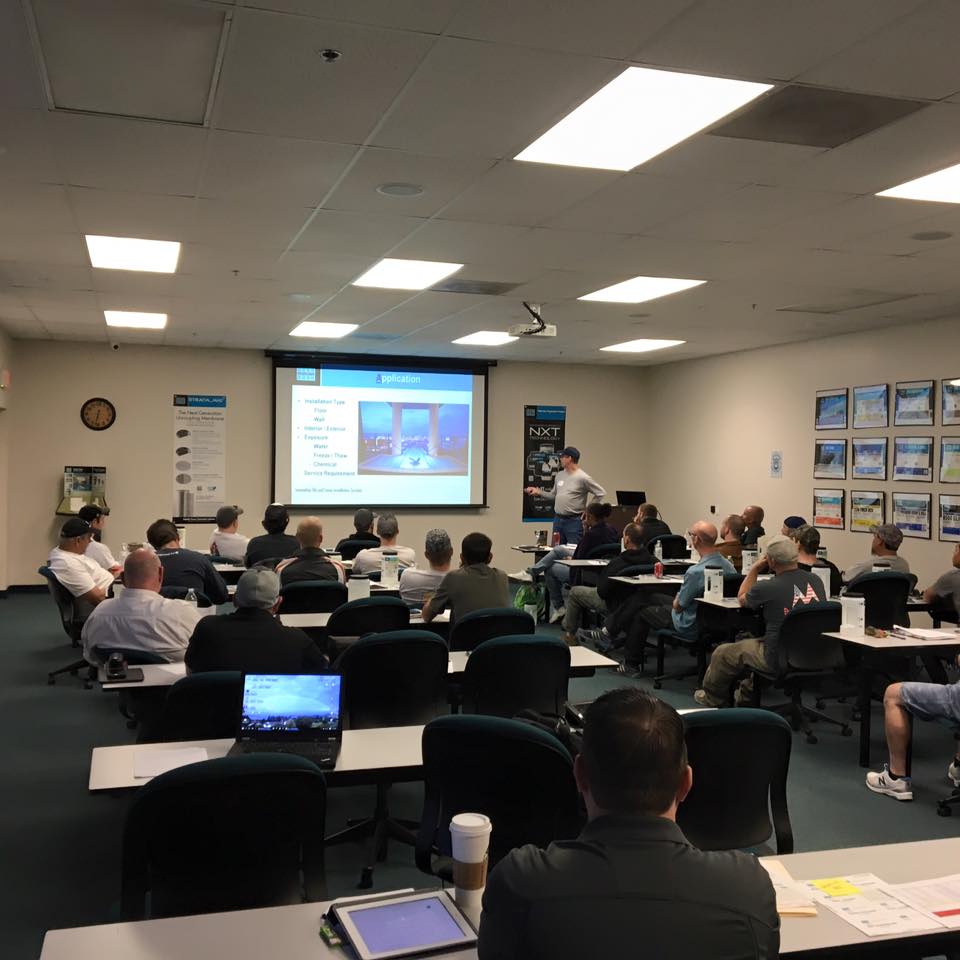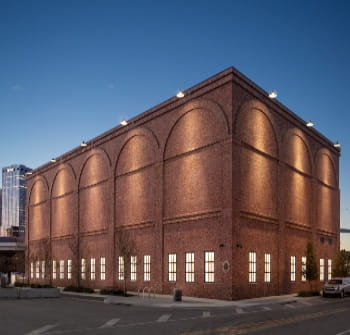Como proveedor de pasaportes internacionales aprobado para el Sistema de Educación Continua (CES) de la AIA, LATICRETE International Inc. está autorizado para ofrecer estos seminarios en cualquier parte del mundo. En estos cursos, aprenderás:
- Los estándares actuales de la industria y los desafíos que se encuentran en la construcción actual.
- Conocimiento de la gran variedad de opciones de sustratos y acabados, y de cómo estas opciones afectan los requisitos de instalación.
- Cómo evitar los problemas de instalación más comunes y costosos.
- Un vistazo a herramientas únicas diseñadas para agilizar el proceso de especificación.
Descargue nuestro folleto del curso AIA aquí o lea más a continuación. Si está interesado en los cursos de IDCEC, envíenos una solicitud a seminars@laticrete.com.
Aspectos destacados del seminario de la AIA
Programas y descripciones
La siguiente es una lista completa de los programas que están registrados y aprobados para presentaciones por AIA para nuestro pasaporte de proveedor. Haga clic en los enlaces para ver la descripción detallada del curso de cada uno.
- AIA-01 - El agua como medio de diseño - Incorporación del agua en sus diseños: ¿Cuáles son los aspectos clave de diseño y especificación que se deben tener en cuenta al diseñar áreas sujetas a exposición al agua? Aprenderá las diferentes opciones para la preparación de la superficie, la impermeabilización, los materiales de colocación y las lechadas, así como también cómo puede beneficiarse de las nuevas tecnologías. Aprenda cómo lograr una instalación exitosa de revestimiento cerámico y piedra en áreas mojadas, mientras compara las diferencias de costo y mano de obra de los diversos métodos de instalación presentados.
- AIA-02 - Solución de problemas con piedra y revestimiento cerámico - ¿Sabe cuáles son algunos de los problemas más comunes a la hora de instalar azulejos y piedras? Aprenda qué causa estos problemas, cómo corregirlos y, lo que es más importante, cómo ayudar a evitar que estos problemas ocurran.
- AIA-03 - Materiales y métodos para la instalación de piedra y revestimiento cerámico - Evite problemas en el lugar de trabajo seleccionando los materiales y métodos de instalación adecuados para revestimiento cerámico y piedra desde el primer momento. Aprenderá a especificar los materiales correctos de revestimiento cerámico y piedra para diversos sustratos, aplicaciones interiores y exteriores, y la técnica de instalación correspondiente para ayudar a garantizar resultados duraderos.
- AIA-04 - Sistemas de Adherencia Directa para Fachadas - ¿De verdad es mucho más difícil instalar revestimiento cerámico y piedra en superficies verticales? Aquí hay una pista: sí. Este curso le enseñará cómo seleccionar los adhesivos y morteros adecuados para garantizar una instalación vertical segura, los problemas más comunes asociados con las instalaciones de fachadas y dónde acceder a los recursos clave para lograr un diseño de fachada icónico.
- AIA-05 - Diseño de instalaciones con mármol y granito - ¿Sabe cómo identificar las diferencias entre el mármol y el granito, y los desafíos de instalar cada superficie? Profundice en cómo se extrae cada tipo de piedra, los sustratos adecuados requeridos, las diferencias físicas entre el mármol y el granito, y las consideraciones al instalar cada uno.
- AIA-07 - Sustentabilidad en la Instalación de Cerámica y Piedra - Aprenda cómo puede especificar un entorno de construcción saludable mientras utiliza baldosas y piedra, y cómo estos materiales encajan en el diseño de edificios ecológicos. También descubrirá cómo seleccionar los métodos de instalación adecuados para ayudar a promover un lugar de trabajo seguro y saludable.
- AIA-08 – Lechada para Cerámica y Piedra - ¿Lechada cementosa o epóxica? ¿Lechada con o sin arena? ¿Cuál es la opción correcta para su trabajo de revestimiento? Aprenda cómo especificar la lechada adecuada para su proyecto de revestimiento cerámico y piedra, los problemas más comunes durante la instalación y cómo el mantenimiento adecuado puede llevar a una instalación duradera.
- AIA-09 - Preparación de la superficie - Las claves para una instalación bonita y duradera comienzan mucho antes de que se coloque la primera baldosa. Aprenda los métodos de preparación adecuados, los sustratos aceptables y las normas mínimas requeridas para una instalación exitosa de revestimiento cerámico y piedra.
- AIA-12 - Restauración de una losa de concreto a la línea de base - Nivelación y repavimentación - ¿ Cuándo necesita un autonivelante en lugar de una capa delgada, y cómo se asegura de que su piso esté correctamente preparado para instalar el producto terminado? Este seminario avanzado analizará los principales beneficios de utilizar un producto autonivelante de cemento de bajo contenido alcalino para restaurar una losa a la línea de base. Se analizarán el diseño y las especificaciones generales para ayudarle a determinar cuándo es necesaria la nivelación del piso en losas nuevas o existentes. Además, en la presentación se compararán varios métodos de aplicación de estos cementos, incluyendo la mezcla en barril y las bombas.
- AIA-13 – Diseño de Sistemas de Instalación y Revestimientos de Porcelana de Espesor Reducido - Con su peso reducido y tamaños más grandes, el revestimiento de porcelana de espesor reducido proporciona un nuevo elemento de diseño casi sin costuras en una variedad de entornos. Conozca las mejores áreas para usar estos azulejos en construcciones nuevas y renovaciones, las herramientas especiales requeridas para un manejo e instalación adecuados, y cómo los azulejos de porcelana de espesor reducido están contribuyendo a los métodos de construcción ecológica.
- AIA-14 - Diseño de hormigón pulido para proyectos LEED y CHPS - Las superficies de concreto pulido son duraderas, de bajo mantenimiento y excelentes para áreas de alto tráfico. En este curso, aprenderá acerca de los avances en equipos de pulido y técnicas de amolado para superficies viejas y nuevas, materiales y métodos de instalación, y cómo las superficies de concreto pulido están contribuyendo a la certificación LEED (Liderazgo en Diseño Energético y Ambiental) y CHPS (Colaboración para Escuelas de Alto Rendimiento).
- AIA-15 - Conceptos básicos del hormigón - Tanto si eres un profano como un profesional experimentado, este curso te enseñará algo sobre el material de construcción más común del mundo: el hormigón. Comience con lo básico y obtenga consejos útiles para instalaciones de concreto adecuadas.
- AIA-16 - Problemas y soluciones del hormigón - El hormigón no está exento de problemas. Esta presentación cubrirá algunos de los problemas más comunes con el concreto y sus causas fundamentales. Vea ejemplos visuales de instalaciones de concreto que salieron mal y cómo se podrían haber evitado. Incluso si eres un profesional experimentado, es posible que aprendas algunos consejos.
- AIA-17 - Concepto erróneo sobre los endurecedores químicos - ¿Por qué querrías usar un endurecedor químico y qué beneficios pueden proporcionar? Derribaremos algunos mitos comunes, presentaremos la ciencia detrás de estos endurecedores y le enseñaremos lo que el proceso de densificación puede agregar a las superficies de concreto.
- AIA-19 - Actualizaciones del Manual del TCNA para arquitectos - El revestimiento cerámico, el vidrio y la piedra constituyen varios de los materiales de acabado más sostenibles y respetuosos con el medio ambiente que puede utilizar para el diseño de edificios ecológicos. El objetivo de este curso es ayudar a los profesionales del diseño a utilizar correctamente el Manual del Consejo de Revestimientos de Norteamérica (Tile Council of North America, TCNA) y especificar las instalaciones de revestimiento cerámico, vidrio y piedra.
- AIA-20 – Sistemas de instalación de rendimiento mejorado para revestimiento de mampostería adherido delgado - La instalación de revestimientos ha evolucionado más allá de los tradicionales listones y rayones. Los cambios en los códigos de construcción y un mayor enfoque en la eficiencia energética han llevado a una nueva generación de sustratos, barreras de aire y agua, y morteros para revestimiento de mampostería adherido delgado. En este curso, obtendrá una comprensión general de estos nuevos estándares en materiales, cómo los métodos de instalación modernos pueden reducir el tiempo y los costos de mano de obra en el trabajo, y cómo los diseños de envolventes de edificios energéticamente eficientes están impulsando las tendencias de construcción.
- AIA-22 – Cubiertas decorativas innovadoras - Adelántese a su competencia y maximice sus ganancias aprendiendo sobre las últimas tendencias en acabados decorativos de concreto y tecnologías de recubrimiento protector. Aprenda cómo lograr instalaciones más rápidas a través de la planificación adecuada del proyecto y la selección de productos, y descubra cómo las tendencias de construcción más ecológicas están llevando a la especificación del concreto decorativo como una solución sostenible.
- AIA-23 – Acabado de hormigón con cemento autonivelante - Las imperfecciones en una losa de concreto pueden traducirse en una mala instalación del piso terminado. El uso de cemento autonivelante puede ayudarlo a lograr las tolerancias deseadas para la planitud y la humedad, lo que da como resultado un mejor producto final. Este curso también desglosará los costos y el impacto laboral del uso de un cemento autonivelante en comparación con el trabajo con llana mecánica más tradicional.
- AIA-25 - Diseño y Técnicas de Duchas Sin Barreras - Los sistemas de duchas sin barreras, también conocidos como duchas sin bordillo o a ras de suelo, abren un nuevo elemento para los diseñadores, con el beneficio adicional de aumentar la accesibilidad para las personas con discapacidades. Antes de comenzar su próximo proyecto, infórmese sobre los materiales nuevos y livianos disponibles, los requisitos del código para una instalación sin barreras y los métodos de instalación adecuados para ayudar a reducir el crecimiento de moho y hongos.
- AIA-26 - Especificación de recubrimientos poliaspárticos para pisos para la sustentabilidad - ¿Cuándo se debe utilizar un recubrimiento poliaspártico? ¿Y cuáles son las diferencias entre los recubrimientos epoxi, uretano y MMA? Este curso lo ayudará a comprender los antecedentes y la química de los diferentes recubrimientos disponibles, cuándo y dónde debe especificar dichos recubrimientos y los beneficios sostenibles de los recubrimientos poliaspárticos.
- AIA-31 - Instalación de azulejos en zonas de alta humedad, calor y piso - Las condiciones ambientales son algunos de los temas más importantes a tener en cuenta al instalar azulejos y piedra. Asegúrese de prepararse para el éxito al comprender cómo la alta humedad, el calor y las áreas propensas a inundaciones afectan directamente las instalaciones, y aprenda los métodos adecuados para ayudar a mitigar estos problemas y garantizar que sus instalaciones resistan los elementos.
- AIA-32 - Sistemas de Paredes Exteriores para Revestimientos Adheridos - ¿Sabe cómo los cambios recientes en el código de construcción han afectado la forma en que se construye la envolvente de un edificio? Diferentes clases de barreras de aire, planos de drenaje, aislamientos continuos... Comprender cada uno de estos elementos y cómo interactúan es crucial. Este curso cubrirá cómo el aire y la humedad entran y salen de un edificio, cómo especificar la barrera de aire correcta para un sustrato, el papel de los planos de drenaje y cómo todos estos elementos trabajan juntos para aumentar la eficiencia energética de un edificio. Los dibujos detallados ayudarán a ilustrar las diferentes opciones de instalación.
- AIA-33 - Las baldosas grandes exigen sustratos planos - ¿Cuánta diferencia puede hacer 1/8"? Bueno, si está instalando baldosas de gran formato o baldosas y paneles de porcelana calibrados, puede significar la diferencia entre una instalación exitosa o tener que regresar al trabajo y reemplazar un piso completo. Obtenga asesoramiento de expertos sobre cómo evitar las trampas de una preparación inadecuada del sustrato, descubra soluciones para lidiar con sustratos irregulares y crear superficies planas adecuadas, y aprenda qué tolerancias son aceptables para estos materiales para pisos cada vez más populares.





